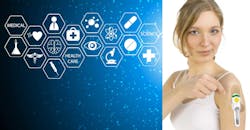Designers and engineers have often looked to the environment and how Mother Nature has accomplished phenomenal design solutions for inspiration over the ages. Perhaps all that is new about this concept is the descriptor, biomimicry.
After all, the concept of the Golden Ratio is a mathematical function of ancient peoples’ acute observation of nature. It can be used in design to achieve beauty, balance and harmony. Leonardo di Vinci, for example, would conveniently have a sketch from nature as a reference on the same pages of his innovative concepts.
A more modern example would be the hook-and-loop fastener, commonly known by the brand Velcro. It was invented by a man who noticed burs and brambles clinging to his clothes and dog. Upon closer inspection, under magnification, he found these seed pods to have tiny hooks that engage fibrous materials that presented a structure resembling a loop.
A Source of Inspiration and Guidance
The connection between biomimicry and medical device design may not be as evident for the healthcare industry as it should be, considering how close medical device design is to the organic intimacy of its context for use. One can look at biomimicry from two perspectives—one is inspirational, and the other is design guidance. The latter is literal mimicry, the result of which is referred to as biomimetics: the natural intersection between biology and engineering.
READ MORE: 5 for Friday: A Look Into the Future for Design, Plant Investments and Pneumatics
An example of inspirational biomimicry could be the observation that certain animals like tortoises and sharks live much longer than other vertebrate animals, which may reveal clues to an age-related therapy. Guidance-type biomimicry could be examining the evolution and mechanical construct of a ram’s skull in the design of a football helmet to understand how rams do not suffer from concussions even with frequent headbutting.
Regardless of the perspective of biomimicry, be it inspirational or guidance, there are opportunities from which medical device designers and engineers can greatly benefit.
A New Regard for Mosquitoes
This creature’s ability to manage microfluidics inspired the conceptualization and development of ideas around drug delivery and blood collection platforms, especially in wearables and injectable devices. Currently most injectable platforms deliver medication at the milliliter scale, rather than the microliter scale, like a mosquito’s transactions.
The first step was to develop technology that mechanically managed microfluidics in a repeatable, extremely precise manner. It was no surprise then, given the Swiss culture, that PreciHealth initially demonstrated the precision of the new technology in the form of a novel type of wristwatch. The commercialization of these watches by the parent company, PreciFlex/HYT, proved the microfluidic precision and enabled the application of the company’s technology into medical devices.
The first application of this technology, inspired by nature’s adept ability to manipulate microfluidics, was in the design of a combination device for the delivery of epinephrine. At the time, current solutions were challenged by two issues. First was the size. An EpiPen can measure 6 in. in length each, and the patient is required to have two of them. The second issue is how readily it can be used incorrectly and end up injecting the user’s thumb.
READ MORE: Micro Solutions Hold Answers to Big Problems
However, the novel microfluidics technology enabled the development of a very small device, about the size of a key fob, with safety features and a more intuitive user interface included. In addition, its smaller form factor better accommodated the requirement for patients to carry two of the devices.
Another case study exemplifies how nature provided design guidance for a device for a patient to collect their own blood sample. The design includes miniature blades for the shallow laceration of capillary vessels. The blades and mechanism mimic the shape of a cat’s claw and how it can extend and retract.
An Innovative R&D Market
These are just two examples of how a young company was able to move from ideation to the creation and manufacture of two products that have radically changed the way patients could, and will likely, interact with devices necessary for managing ongoing health issues. The market is ripe for more innovation as the trend moves toward empowering patients in the management of their healthcare and as clinical environments are embracing more technology-enhanced medical devices.
READ MORE: Building a MedTech Metaverse
According to Grandview Research, the fast growth of medical biomimetics market is mainly driven by increased government funding for research pertaining to biomimetics, along with the adoption and innovations of medical engineering and nanotechnology in healthcare.
With government funding on the increase and agile start-ups looking to develop new and less complicated ways to deliver needed medical technologies both at home and in clinical environments, designers and engineers can benefit from biomimicry in the conceptualization and development of exciting new medical devices.
Finding inspiration in nature may not be a new concept, but technology has given the industry new tools to successfully leverage innovative ideas and design solutions for medical devices based on what’s readily available in our natural environment.
Jeff Morang is director of Human Factors Engineering at BlackHӓgen Design.

